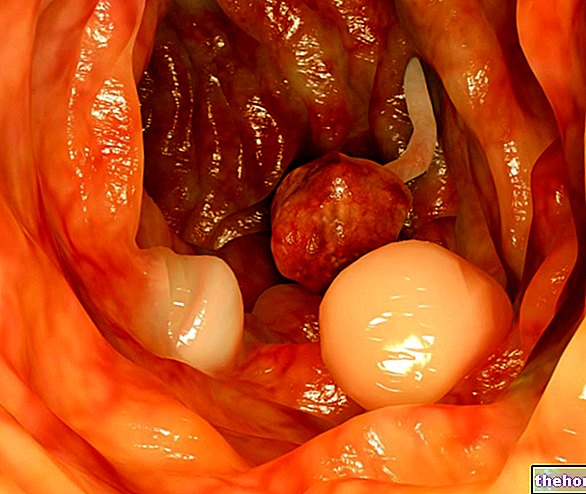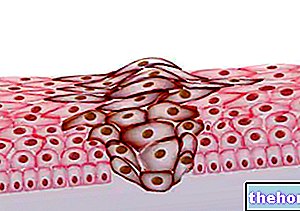Generality
Adenoma is a benign tumor that originates in a tissue with secretory properties (glands and mucous membranes) and / or that assumes the appearance of a gland.
Specifically, adenomas can originate from the epithelial cells of the exocrine glandular organs (for example pituitary, thyroid, breasts, adrenal glands, parathyroid, etc.) or from the epithelial cells of tissues with secretory properties (for example, mucosa lining the esophagus, stomach or colon).

The most common human adenoma is colon adenoma, better known as intestinal polyp.
The diagnosis of adenoma is based on a biopsy (or biopsy examination): the latter allows us to understand whether the tumor mass is benign (adenoma) or malignant (adenocarcinoma).
Differences between a benign tumor and a malignant tumor
In medicine, the word "tumor" or "neoplasm" means a mass of abnormal cells, which have a higher rate of growth and division than normal cells.
A benign tumor is a neoplasm with a relatively low growth rate, low infiltrative power and equally scarce (if any) metastasizing power.
On the contrary, a malignant tumor is a neoplasm with a very considerable growth rate, a high infiltrative power and a high metastasizing power.
Please note: by infiltrative power, s "means the ability to affect adjacent anatomical regions.
With metastasizing power, on the other hand, we refer to the ability of cancer cells to spread, through the blood or the lymphatic circulation, to other organs and tissues of the body (metastasis).
So it is an adenoma
An adenoma is a benign tumor that originates from the epithelial cells of exocrine glandular organs or from the epithelial cells of tissues with secretory properties.
Examples of exocrine glandular organs are the breasts, the thyroid gland, the pituitary gland, the adrenal glands, the parathyroid and the prostate; examples of tissues with secretory properties, on the other hand, are the layers of mucosa that line the internal wall of the esophagus, stomach , colon or rectum.
What are epithelial cells?
Constituting epithelial tissues, epithelial-type cells are the cellular elements that line the surfaces of all external and internal structures of the human body, including cavities and glands.
ORIGIN OF THE NAME
The word "adenoma" has Greek origin and derives from the "union of the terms" adenas "(αδένας), which means "gland" and refers to the "glandular apparatus, and" oma "(ώμα), which means "tumor".
Therefore the literal meaning of adenoma is "glandular tumor" or "tumor of a gland".
EVIL EQUIVALENT
The malignant equivalent of adenoma (understood as a category of benign tumors) is adenocarcinoma.
Adenocarcinomas fall into the malignant tumor category of carcinomas. A carcinoma is any malignant neoplasm originating from an epithelial-type cell.
Carcinomas possess a high infiltrating power and a marked metastasizing capacity: all this makes them conditions with a poor prognosis, especially in the case of late diagnosis.
Returning to adenocarcinomas, these can sometimes result from an adenoma. An adenoma which, quite frequently, assumes the characteristics of a malignant tumor is the colon adenoma: from it derives the so-called colorectal adenocarcinoma.
The most common adenocarcinomas:
- Colorectal adenocarcinoma
- Lung adenocarcinoma
- Breast adenocarcinoma
- Adenocarcinoma of the pancreas
- Adenocarcinoma of the esophagus
- Prostate adenocarcinoma
Causes
The human body contains just over 37 trillion cells. These cells have a life cycle, which includes a growth phase, a division phase, and a death phase.
The entire life cycle of a generic cell in the human body depends on the genetic heritage contained in the cell nucleus and known as DNA.
DNA is a highly efficient and precise "machine", capable of accurately directing and controlling all the most important phases of a cell's path, from birth to death.
An adenoma (as well as all benign tumors and malignant tumors) arises as a result of irreparable damage to the DNA (mutation), damage that prevents the DNA itself from regulating the cellular processes of growth, division and death with precision and accuracy.
It follows that the cell or cells involved in the mutation of the genetic heritage grow and divide in an uncontrolled way (we also speak of uncontrolled cell proliferation).
The cells of an adenoma - but in reality all the cells of a benign or malignant neoplasm - also take the name of "crazy cells": this terminology indicates precisely the "anomaly that distinguishes them and the characteristic lack of control in the processes of growth and division.
A FEW MORE DETAILS ABOUT MUTATIONAL PROCESSES
What causes any adenoma - as well as another benign or malignant tumor - is never a single DNA mutation, but a series of mutations.
Generally, the mutations that cause an adenoma, in a human being, appear at different moments in life; in other words, the uncontrolled cell proliferation, typical of adenomas, is the result of a slow accumulation of mutations during the aging process.
The fact that the development of a benign or malignant tumor takes a long time explains why the patients are, except in special cases, middle-aged or elderly adults.
Young people with an adenoma or adenocarcinoma (or any other type of cancer) are particularly unfortunate individuals, as the accumulation of mutations has been very rapid for them.
Please note: what has been described above on the accumulation of mutations has particular value for malignant tumors. A malignant tumor is a classic example of a neoplastic process due to numerous mutational steps, which take place in the course of life.
Fun fact: DNA has a defense system that corrects mutations
Among the various activities of human DNA, there is also that of generating proteins designed to correct the mutations that, in the course of life, affect the DNA itself. In other words, our genetic patrimony possesses a system of self-defense against mutations.
This self-defense system is very effective; however, in some cases, it fails or makes mistakes and this involves the permanence of one or more mutations in the DNA.
Generally, it is the errors of the defense system against mutations that lay the foundations for the development of malignant neoplasms.
Histopathology
Without going into too much detail, from a histological point of view it is important to note that:
- An adenoma can present with varying degrees of dysplasia. In fact, there are adenomas with low-grade dysplasia, adenomas with moderate-grade dysplasia and adenomas with high-grade dysplasia.
Remember that the term dysplasia indicates an abnormal cellular development of a tissue or organ. Dysplastic cells are cells that, compared to their normal counterparts, are altered in shape and size, have oddities at the level of the internal organelles and organize themselves in an anomalous way. - According to the characteristics of the epithelium, there are: trabecular or solid adenomas (for example: liver and adrenal glands), tubular adenomas, alveolar adenomas (for example: intestine, uterus, breasts, kidney and ovary) and follicular adenomas (for example: thyroid and ovary).
Types
The criterion used for the distinction of adenomas is the localization of the tumor mass.
The best known human adenomas are:
- Colon adenoma
- The pituitary adenoma
- The thyroid adenoma
- Breast adenoma
- The renal adenoma
- The adrenal adenoma
- The parathyroid adenoma
- The hepatic adenoma
- The bronchial adenoma
- The sebaceous adenoma
- Salivary gland adenoma or pleomorphic adenoma.
ADENOMA OF THE COLON
The colon - the most important section of the large intestine - is the organ in the human body that most frequently develops adenomas.
Usually identified through a colonoscopy, colon adenoma is also known as an adenomatous polyp or intestinal polyp.
Generally, doctors strongly recommend surgical removal of intestinal polyps, as their transformation into adenocarcinomas is quite frequent.
According to a "reliable statistical survey, 40% of people over 60 have one or more adenomas of the colon.
To learn more about "intestinal adenomatous polyps", the reader can consult the articles present here (overview on intestinal polyps), here (symptoms), here (videos on causes, symptoms, etc.) and here (drugs).
HYPOPHYSARY ADENOMA
The pituitary adenoma originates from the cells of the pituitary, an endocrine gland located at the base of the skull (precisely below the diencephalon) and responsible for the secretion of hormones that regulate numerous and important functions of the organism.
The formation of a pituitary adenoma can affect the functionality of the pituitary in two opposite ways:
- By increasing the activity of hormonal secretion;
- By blocking the release of hormones into the circulation.
In other words, therefore, pituitary adenomas have the ability to alter the production of hormones by the pituitary.
The size of a pituitary adenoma depends on the symptoms: large pituitary adenomas are often associated with very marked symptoms (the tumor mass pushes on nearby anatomical structures), while small pituitary adenomas can sometimes be completely asymptomatic (in these situations, their diagnosis occurs by chance).
Typically, the treatment of a pituitary adenoma involves drug therapy, radiation therapy, and surgery to remove the tumor.
To know in detail the causes, symptoms and therapy of pituitary adenoma, readers can consult the articles here (causes and symptoms) and here (therapy)
ADENOMA THYROID
Thyroid adenoma, also known as a thyroid nodule, is an adenoma that originates from the cells of the thyroid gland.
The thyroid is an unequal, butterfly-shaped glandular organ located in the anterior region of the neck at the base of the throat.
Through the secretion of three hormones (triiodothyronine, thyroxine and calcitonin), the thyroid regulates very important physiological processes, including:
- The body metabolism
- Skeletal and brain development
- Protein synthesis
- The development of the skin, the hair system and the genital organs
- The heartbeat
- Body temperature
- L "hematopoiesis
Thyroid adenomas can be asymptomatic - therefore without associated symptoms - or they can cause hyperthyroidism and various compression effects (for example, if they compress the trachea, make breathing difficult, etc.).
When a thyroid adenoma is symptomatic, doctors tend to recommend a thyroidectomy, which is the surgery aimed at removing part of the thyroid.
To know in detail the symptoms and therapy of thyroid adenoma, readers can consult the article here (symptoms) and here (cure).
BREAST ADENOMA
Typical of women between 15 and 30 years of age, breast adenoma (or breast fibroadenoma) is an adenoma that originates from the glandular tissue of the breasts, precisely from the so-called breast lobules.
On palpation, a breast adenoma may resemble a lump or marble. Its consistency varies from subject to subject: in some women, it is rubbery; in others, however, it is rigid.
There are two types of breast adenoma: the simple and the complex.
Simple breast adenoma is generally harmless, as it tends to remain stable throughout life.
On the contrary, complex breast adenoma is a type of benign tumor that can evolve and become malignant. This explains why, in its presence, doctors recommend periodic monitoring of the anomaly.
According to "reliable research carried out in the United States, every year, 10% of US women develop breast adenoma.
Diagnosis
For an accurate diagnosis of adenoma, biopsy is essential.
Through the biopsy examination, in fact, doctors are able to study in detail the cellular and molecular characteristics of the tumor mass and understand whether it is a benign or malignant tumor.
An important parameter, which emerges from the biopsy and which gives an "idea of the severity of an adenoma, is the degree of dysplasia.
Prognosis
The prognosis of an adenoma depends on various factors, including: location, degree of dysplasia and malignant transformation.




























